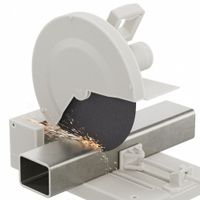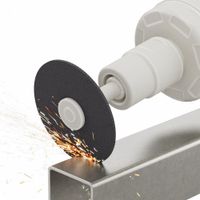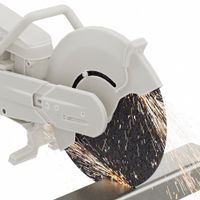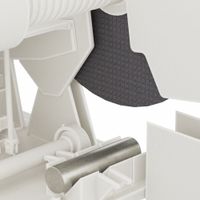Call +(254) 703 030 000 / 751 483 999 / 721 704 777
- Home
- Abrasives
- Cut Off Grinding Abrasives
- Cut Off Wheels
.....Read More
Frequently Asked Questions
What is the correct way to install a cut-off wheel on an angle grinder?
1. **Safety First**: Ensure the angle grinder is unplugged or the battery is removed to prevent accidental start-up. Wear safety goggles, gloves, and a dust mask.
2. **Select the Right Wheel**: Choose a cut-off wheel that is compatible with your angle grinder and suitable for the material you are cutting.
3. **Inspect the Wheel**: Check the cut-off wheel for any cracks or damage. Do not use a damaged wheel.
4. **Remove the Existing Wheel**: If there is an existing wheel, use the wrench provided with the grinder to loosen the nut or flange holding the wheel in place. Press the spindle lock button to keep the spindle from turning while you loosen the nut.
5. **Position the Cut-off Wheel**: Place the new cut-off wheel onto the spindle. Ensure the label side is facing outwards, unless otherwise specified by the manufacturer.
6. **Secure the Wheel**: Place the flange or nut back onto the spindle. Hand-tighten it first, then use the wrench to secure it. Do not overtighten, as this can damage the wheel.
7. **Check Alignment**: Ensure the wheel is properly aligned and spins freely without wobbling.
8. **Test Run**: Plug in the grinder or reattach the battery. Hold the grinder firmly and start it in a safe area to ensure the wheel is installed correctly and there are no vibrations or unusual noises.
9. **Begin Cutting**: Once confirmed, proceed with your cutting task, maintaining a firm grip and using both hands for control.
10. **Regular Checks**: Periodically check the wheel for wear and ensure it remains securely fastened during use.
How do I choose the right cut-off wheel for different materials?
To choose the right cut-off wheel for different materials, consider the following factors:
1. **Material Type**:
- **Metal**: Use aluminum oxide wheels for ferrous metals like steel and iron. For non-ferrous metals like aluminum and copper, silicon carbide wheels are preferable.
- **Stainless Steel**: Opt for wheels with zirconia alumina or ceramic grains to prevent contamination and ensure a clean cut.
- **Concrete/Stone**: Silicon carbide wheels are suitable for cutting masonry, concrete, and stone.
- **Ceramics/Glass**: Diamond wheels are ideal for cutting hard, brittle materials like ceramics and glass.
2. **Wheel Composition**:
- **Bond Type**: Resin-bonded wheels are versatile and suitable for most applications. Metal-bonded wheels are more durable and ideal for heavy-duty cutting.
- **Grain Size**: Coarse grains (lower grit numbers) are better for fast, rough cuts, while fine grains (higher grit numbers) provide smoother finishes.
3. **Wheel Diameter and Thickness**:
- Larger diameter wheels are used for deeper cuts, while smaller ones offer more control for precision work.
- Thinner wheels provide faster cuts with less material waste but may wear out quicker. Thicker wheels are more durable and suitable for heavy-duty applications.
4. **Speed and Power**:
- Ensure the wheel's maximum RPM rating matches or exceeds the tool's speed to prevent breakage.
- Consider the power of your tool; higher power tools can handle more aggressive cutting wheels.
5. **Application and Environment**:
- For dry cutting, ensure the wheel is designed for dry use. For wet cutting, use wheels that can handle water cooling.
- Consider the working environment, such as indoor or outdoor, and choose wheels that minimize dust and noise if necessary.
6. **Safety and Compliance**:
- Always select wheels that comply with safety standards like ANSI or EN12413.
- Check for any specific manufacturer recommendations for your tool and material.
By considering these factors, you can select the appropriate cut-off wheel for your specific material and application needs.
What safety precautions should I take when using cut-off wheels?
When using cut-off wheels, prioritize safety by following these precautions:
1. **Personal Protective Equipment (PPE):** Wear safety goggles or a face shield to protect against flying debris. Use hearing protection to guard against noise. Wear gloves to protect your hands and a dust mask or respirator to avoid inhaling dust.
2. **Inspect the Wheel:** Before use, check the cut-off wheel for cracks, chips, or other damage. Do not use a damaged wheel.
3. **Proper Mounting:** Ensure the wheel is properly mounted and secured on the tool. Use the correct flanges and never overtighten the mounting nut.
4. **Tool Compatibility:** Use the wheel only on tools designed for cut-off wheels. Ensure the wheel's speed rating matches or exceeds the tool's maximum speed.
5. **Guard Usage:** Always use the safety guard provided with the tool. It should cover at least half of the wheel to protect against fragments.
6. **Secure the Workpiece:** Firmly secure the material being cut to prevent movement during operation.
7. **Correct Positioning:** Stand to the side of the wheel, not directly in line with it, to avoid injury from wheel breakage.
8. **Avoid Side Pressure:** Do not apply side pressure to the wheel. Cut-off wheels are designed for straight cuts only.
9. **Proper Storage:** Store wheels in a dry, cool place to prevent damage and deterioration.
10. **Clear Work Area:** Keep the work area clean and free of obstructions. Ensure adequate lighting.
11. **Training and Awareness:** Ensure all operators are trained in the proper use of cut-off wheels and are aware of the potential hazards.
12. **Emergency Preparedness:** Have a first aid kit and fire extinguisher nearby in case of accidents.
By adhering to these precautions, you can minimize risks and ensure a safer working environment when using cut-off wheels.
Can cut-off wheels be used on both metal and non-metal materials?
Yes, cut-off wheels can be used on both metal and non-metal materials, but there are important considerations to ensure safety and effectiveness.
Cut-off wheels are abrasive discs designed for cutting through various materials. They are commonly used with angle grinders, stationary cut-off saws, or other power tools. The key to using cut-off wheels on different materials lies in selecting the appropriate type of wheel for the specific material you intend to cut.
For metal cutting, cut-off wheels are typically made from aluminum oxide or zirconia alumina. These materials are suitable for cutting ferrous metals like steel and iron, as well as non-ferrous metals such as aluminum and copper. When cutting metal, it's crucial to use a wheel specifically labeled for metal to ensure efficient cutting and to prevent damage to the wheel or the material.
For non-metal materials, such as stone, tile, or concrete, cut-off wheels made from silicon carbide or diamond are more appropriate. Silicon carbide wheels are effective for cutting through masonry, ceramics, and other hard, brittle materials. Diamond wheels, which have a diamond coating, are particularly effective for cutting through very hard materials like concrete and stone.
It's important to note that using the wrong type of cut-off wheel for a material can lead to poor performance, increased wear on the wheel, and potential safety hazards. Always check the manufacturer's specifications and ensure the wheel is rated for the material you are cutting. Additionally, proper safety gear, such as eye protection, gloves, and hearing protection, should always be used when operating tools with cut-off wheels.
How do I know when a cut-off wheel needs to be replaced?
1. **Visible Damage**: Inspect the wheel for cracks, chips, or any visible damage. If any are present, replace the wheel immediately to prevent accidents.
2. **Reduced Cutting Efficiency**: If the wheel is taking longer to cut through materials or requires more pressure than usual, it may be worn out and needs replacement.
3. **Excessive Vibration**: Increased vibration during use can indicate an imbalance or damage in the wheel, suggesting it should be replaced.
4. **Unusual Noises**: Listen for any unusual sounds such as grinding or squealing, which can indicate that the wheel is worn or damaged.
5. **Size Reduction**: As the wheel wears down, its diameter decreases. If the wheel becomes too small for effective use or does not meet the minimum size requirement for your tool, it should be replaced.
6. **Burn Marks**: If you notice burn marks on the material being cut, it may indicate that the wheel is dull and needs replacing.
7. **Glazing**: A shiny or glazed appearance on the wheel surface can indicate that it is no longer effective and should be replaced.
8. **Material Build-up**: If material builds up on the wheel, it can affect performance. If cleaning does not restore efficiency, replacement is necessary.
9. **Expiration Date**: Check the manufacturer's expiration date. Even if unused, wheels can degrade over time and should be replaced if past their expiration.
10. **User Manual Guidelines**: Always refer to the tool and wheel manufacturer's guidelines for specific replacement indicators and safety recommendations.
What is the difference between a cut-off wheel and a grinding wheel?
A cut-off wheel and a grinding wheel are both abrasive tools used in metalworking and other material processing applications, but they serve different purposes and have distinct characteristics.
A cut-off wheel, also known as a cutting disc, is designed specifically for cutting through materials. It is typically thin, often around 1/16 to 1/8 inch thick, which allows it to make precise, clean cuts with minimal material waste. Cut-off wheels are used with angle grinders, stationary cut-off saws, or other cutting tools. They are ideal for slicing through metal, steel, stainless steel, and other hard materials. The thinness of the wheel reduces friction and heat generation, which helps in achieving a faster cut.
In contrast, a grinding wheel is thicker and is used for grinding, shaping, or smoothing surfaces. Grinding wheels are designed to remove material from a workpiece, which can include tasks like deburring, surface preparation, and finishing. They are available in various thicknesses and grit sizes, allowing for different levels of material removal and surface finish. Grinding wheels are used with bench grinders, angle grinders, and other grinding machines. They are suitable for tasks that require more force and material removal, such as smoothing welds, sharpening tools, or preparing surfaces for painting.
In summary, the primary difference lies in their purpose and design: cut-off wheels are thin and used for cutting, while grinding wheels are thicker and used for material removal and surface finishing.
How do I prevent cut-off wheels from shattering during use?
To prevent cut-off wheels from shattering during use, follow these guidelines:
1. **Proper Selection**: Choose the right wheel for the material and machine. Ensure the wheel's RPM rating matches or exceeds the tool's speed.
2. **Inspection**: Before use, inspect the wheel for cracks, chips, or other damage. Discard any compromised wheels.
3. **Correct Mounting**: Ensure the wheel is properly mounted on the tool. Use the correct flanges and never force the wheel onto the spindle.
4. **Tightening**: Secure the wheel with the appropriate torque. Over-tightening can stress the wheel, while under-tightening can cause slippage.
5. **Guard Use**: Always use the safety guard provided with the tool. It helps contain fragments if the wheel shatters.
6. **Tool Condition**: Maintain the tool in good working condition. Check for worn bearings or misalignment that can cause vibration.
7. **Safe Operation**: Operate the tool at the correct angle and avoid side pressure on the wheel. Use a steady, even pressure without forcing the wheel through the material.
8. **Personal Protective Equipment (PPE)**: Wear safety goggles, face shields, gloves, and appropriate clothing to protect against flying debris.
9. **Training**: Ensure operators are trained in the correct use of cut-off wheels and understand the risks involved.
10. **Storage**: Store wheels in a dry, temperature-controlled environment to prevent damage from moisture or temperature fluctuations.
11. **Avoiding Jams**: Do not twist or jam the wheel in the cut. This can cause stress and lead to shattering.
12. **Regular Breaks**: Allow the wheel to cool down during extended use to prevent overheating, which can weaken the wheel.
By adhering to these practices, you can significantly reduce the risk of cut-off wheel shattering and ensure a safer working environment.




